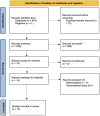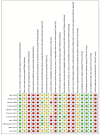Comparison of Intraoperative Imprint Cytology versus Frozen Section for Sentinel Lymph Node Evaluation in Breast Cancer. A study along with Systematic Review and Meta-analysis of literature
- PMID: 38679970
- PMCID: PMC11162742
- DOI: 10.31557/APJCP.2024.25.4.1113
Comparison of Intraoperative Imprint Cytology versus Frozen Section for Sentinel Lymph Node Evaluation in Breast Cancer. A study along with Systematic Review and Meta-analysis of literature
Abstract
Background: Sentinel lymph node (SLN) is the first lymph node to drain the lymph from a particular region involved by cancer. The commonly performed intraoperative methods for SLN evaluation are touch imprint cytology (TIC) and frozen section (FS). The present study aimed to determine the sensitivity, specificity and accuracy of TIC and FS with histopathological diagnosis as gold standard.
Materials and methods: The nodes were bissected along their long axis and wet surface was imprinted on to clean glass slides followed by toluidine blue and rapid Papanicolaou staining. Subsequently the lymph node slices were cut at three levels using the cryostat machine and stained with Hematoxylin and eosin stain. The cytological and FS findings were compared and the specificity, sensitivity, accuracy, positive predictive value (PPV) and negative predictive value (NPV) of TIC and FS was evaluated taking histopathological diagnosis as gold standard. In addition, pooled sensitivity, specificity, positive predictive value, negative predictive value and diagnostic accuracy for touch imprint cytology and frozen section were assessed for the studies included in the meta-analysis.
Results: The specificity, sensitivity, diagnostic accuracy, positive predictive value and negative predictive value of touch imprint cytology were 100%, 88.2%, 90%, 100% and 60% respectively. The specificity, sensitivity, diagnostic accuracy, PPV and NPV of frozen section were 100%, 94.1%, 95%, 100% and 75% respectively. The sensitivity of TIC and FS for detection of micrometastasis was 60% and 80% respectively. The pooled sensitivity and specificity for touch imprint cytology were 85.24% (95% CI, 83.46%-86.90%), and 98.99% (95% CI, 98.69%-99.23%) respectively. The pooled sensitivity and specificity for frozen section examination were 90.45% (95% CI, 85.15%-94.34%), and 100% (95% CI, 99.24%-100%) respectively.
Conclusion: Even though the sensitivity of FS was better than imprint cytology in detection of micrometastasis, TIC is a rapid inexpensive technique which can be utilized in remote areas in absence of cryostat machine. The sensitivity of the two techniques with respect to detection of macrometastasis was comparable. This meta-analysis highlights the accuracy of the touch imprint cytology and frozen section examination in the intra-operative detection of malignancy in breast cancer.
Keywords: Meta-analysis; Sentinel Lymph Node; breast cancer; frozen section; touch imprint cytology.
Conflict of interest statement
None.
Figures






Similar articles
-
Comparing touch imprint cytology, frozen section analysis, and cytokeratin immunostaining for intraoperative evaluation of axillary sentinel lymph nodes in breast cancer.Indian J Pathol Microbiol. 2012 Apr-Jun;55(2):183-6. doi: 10.4103/0377-4929.97859. Indian J Pathol Microbiol. 2012. PMID: 22771640
-
Prospective Comparison of Intraoperative Touch Imprint Cytology and Frozen Section Histology on Axillary Sentinel Lymph Nodes in Early Breast Cancer Patients.Acta Cytol. 2020;64(5):492-497. doi: 10.1159/000508016. Epub 2020 May 25. Acta Cytol. 2020. PMID: 32450564
-
Evaluation Of Intraoperative Touch Imprint Cytology Of Axillary Sentinel Lymph Node Accuracy In Comparison To The Permanent Histology Diagnosis. A prospective study Of 25 Invasive Breast Cancers.Gulf J Oncolog. 2021 Sep;1(37):70-78. Gulf J Oncolog. 2021. PMID: 35152198
-
A Systematic Review and Meta-analysis of Touch Imprint Cytology and Frozen Section Biopsy and Their Comparison for Evaluation of Sentinel Lymph Node in Breast Cancer.World J Surg. 2023 Feb;47(2):478-488. doi: 10.1007/s00268-022-06800-w. Epub 2022 Oct 30. World J Surg. 2023. PMID: 36310323
-
Breast cancer micrometastasis and axillary sentinel lymph nodes frozen section. Our experience and review of literature.Int J Surg. 2014;12 Suppl 1:S12-5. doi: 10.1016/j.ijsu.2014.05.044. Epub 2014 May 22. Int J Surg. 2014. PMID: 24859398 Review.
References
-
- Giuliano AE, Edge SB, Hortobagyi GN. Eighth edition of the ajcc cancer staging manual: Breast cancer. Ann Surg Oncol. 2018;25(7):1783–5. - PubMed
-
- Kootstra JJ, Hoekstra-Weebers JE, Rietman JS, de Vries J, Baas PC, Geertzen JH, et al. A longitudinal comparison of arm morbidity in stage i-ii breast cancer patients treated with sentinel lymph node biopsy, sentinel lymph node biopsy followed by completion lymph node dissection, or axillary lymph node dissection. Ann Surg Oncol. 2010;17(9):2384–94. - PMC - PubMed
-
- Safai A, Razeghi A, Monabati A, Azarpira N, Talei A. Comparing touch imprint cytology, frozen section analysis, and cytokeratin immunostaining for intraoperative evaluation of axillary sentinel lymph nodes in breast cancer. Indian J Pathol Microbiol. 2012;55(2):183–6. - PubMed
Publication types
MeSH terms
LinkOut - more resources
Full Text Sources
Medical

